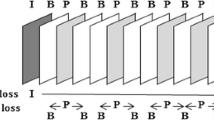Abstract
To guarantee the quality of video data into fast-responding transmission and high resolution output video using cost effective video processing is desirable in many services including Internet of Things (IoT) applications. The goal of this study is to develop a transmission method to improve a quality of service (QoS) to support for various multimedia contents with high quality on 5 generation (5G) convergence network. The main motivation is based on video feature and dependency between frames and blocks in coding structure. First, we investigate the existing methods and analyze them into some classes. From the analyzed result, we propose a priority-based key frame protection method for improving QoS of in 5G convergence network.














Similar content being viewed by others
References
Abdel KA, Caramanis C, Heath RW (2012) A cross-layer design for perceptual optimization of H. 264/SVC with unequal error protection. IEEE J Sel Areas Commun 30:1157–1171
Aign S, Fazel K (1995) Temporal and spatial error concealment technique for hierarchical MPEG-2 video codec. In: IEEE international conference on communications, pp 1778–1783
Atzori L, Iera A, Morabito G (2010) The internet of things. A survey. Comput Netw 54:2787–2805
A.V.C. for Generic Audio-Visual Services, ITU-T Rec. H.264 and ISO/IEC 14496- 10(AVC). ITU-T and ISO/IEC JTC 1 (2003)
Azfar M, Fapojuwo AO (2009) A cross-layer framework for efficient streaming of H. 264 video over IEEE 802.11 networks. J Comput Syst Netw Commun 682813:1–13
Chen Y, Yu K, Li J, Li S (2004) An error concealment algorithm for entire frame loss in video transmission. In: IEEE picture coding symposium, vol 1, pp 1–4
Chien J-T, Li G-L, Chen M-J (2010) Effective error concealment algorithm of whole frame loss for H.264 video coding standard by recursive motion vector refinement. IEEE Trans Consum Electron 56:1689–1695
Cisco (2014) Cisco Visual Networking Index: Global Mobile Data Traffic Forecast Update, 2013–2018
Ericsson (2013) More than 50 billion connected devices. Technical Report (Ericsson) 1
Fang T, Chau L (2006) GOP-based channel rate allocation using genetic algorithm for scalable video streaming over error-prone networks. IEEE Trans Image Process 15:1323–1330
Foukalas F, Gazis V, Alonistioti N (2008) Cross-layer design proposals for wireless mobile networks: a survey and taxonomy. IEEE Commun Surv Tutor 10:70–85
Go K (2016) A systematic reallocation and prioritization scheme for error-resilient trans- mission of video packets. Multimedia Tools Appl 76:6755–6783
Goyal VK (2001) Multiple description coding: compression meets the network. IEEE Signal Process Mag 18:74–93
Greengrass J, Evans J, Begen AC (2009) Not all packets are equal part II: the impact of network packet loss on video quality. IEEE Internet Comput 13:74–82
Guang-Tung J, Chen M-J, Chi M-C (2006) Effective error concealment algorithm by boundary information for H. 264 Video Decoder. In: IEEE international conference on multimedia and expo, vol 1, pp 2021–2024
Ha H, Yim C (2008) Layer-weighted unequal error protection for scalable video coding ex- tension of H.264/AVC. IEEE Trans Consumer Electron 54:736–744
Jassal A et al (2015) A packet prioritization scheme for 3D-HEVC content transmission over LTE networks. In: International conference on communication workshop (ICCW), pp 1788–793
Kim M-H, Park J-H, Na M-S, Jo S-H (2015) Trend of 5G Wireless mobile Communication. Report KICS 1:46–54
Kokkonis G, Psannis K, Roumeliotis M, Schonfeld D (2017) Real-time wireless multi- sensory smart surveillance with 3d-hevc streams for internet of things (iot). J Supercomput 73:1044–1062
Ksentini A, Naimi M, Guroui A (2006) Toward an improvement of H. 264 video transmission over IEEE 802.11 e through a cross-layer architecture. IEEE Commun Mag 44:107–114
Lung-Jen W, Wu C-E, Chang C-Y (2015) A cross-layer based bandwidth and queue adaptations for wireless multimedia networks. Computational intelligence, communication systems and networks , pp 227–232
MCKinsey (2014) The Internet of Things: sizing up the opportunity. MCKinsey, USA
M of Korea (2014) Statistics of wireless data traffic. In: Government Report
Psannis K, Ishibashi Y (2006) Impact of video coding on delay and jitter in 3G wireless video multicast services. EURASIP J Wirel Commun Netw 24614:1–7
Psannis K, Ishibashi Y (2008) Enhanced H.264/AVC stream switching over varying bandwidth networks. IEICE ELEX J 5:827–832
Shankar S, van der Schaar M (2007) Performance analysis of video transmission over IEEE 802. 11a/e WLANs. IEEE Trans Veh Technol 56:2346–2362
Stockhammer T (2011) Dynamic adaptive streaming over HTTP: standards and design principles. In: ACM multimedia systems conference, pp 133–144
Sullivan GJ, Ohm J-R, Han W-J, Wiegand T (2012) Overview of the High Efficiency Video Coding (HEVC) Standard. IEEE Trans Circuits Syst Video Technol 22:1649–1668
van der Schaar M (2005) Cross-layer wireless multimedia transmission: challenges, principles, and new paradigms. IEEE Wirel Commun Mag 12:55–58
Wenger S (2003) H.264/AVC over IP. IEEE Trans Circ Syst Video Technol 13:645–656
x265, http://x265.org/. Multicoreware Inc. (2017)
Zhang XJ et al (2008) Robust video transmission over lossy network by exploiting H. 264/AVC data partitioning. In: International conference on broadband communications networks and systems, vol 1, pp 1–8
Acknowledgements
This work was supported by Institute for Information & communications Technology Promotion(IITP) grant funded by the Korea government(MSIP) (No.B0132-16-1005, Development of Wired-Wireless Converged 5G Core Technologies)
Author information
Authors and Affiliations
Corresponding author
Rights and permissions
About this article
Cite this article
Lee, JH., Hong, GS., Lee, YW. et al. Design of Efficient Key Video Frame Protection Scheme for Multimedia Internet of Things (IoT) in Converged 5G Network. Mobile Netw Appl 24, 208–220 (2019). https://doi.org/10.1007/s11036-018-1107-y
Published:
Issue Date:
DOI: https://doi.org/10.1007/s11036-018-1107-y





